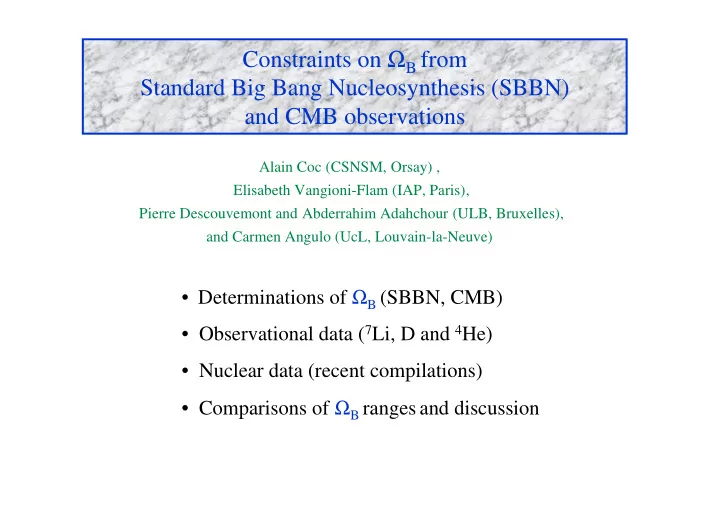

Constraints�on� Ω B� from� Standard�Big�Bang�Nucleosynthesis (SBBN)� and CMB�observations Alain�Coc (CSNSM,�Orsay)�, Elisabeth�Vangioni-Flam�(IAP,�Paris), Pierre�Descouvemont�and Abderrahim�Adahchour (ULB,�Bruxelles), and�Carmen�Angulo�(UcL,�Louvain-la-Neuve) • Determinations�of� Ω B� (SBBN,�CMB) • Observational�data�( 7 Li,�D�and� 4 He) • Nuclear�data�(recent�compilations)� • Comparisons�of� Ω B� ranges and�discussion
� Density�components�of�the�Universe A�natural�reference�:�the�critical�density : 2 3 H ρ = 0 =�1.88� h 2� × 10 -29 g/cm 3� or 2.9� h 2� × 10 11 M /Mpc 3 π C 8 G ( h =H 0 /100�km/s/Mpc h =0.71) Ω≡ ρ / ρ C Some� Ω values Ω L Visible�matter ~0.002 Ω b 0.044 ± 0.004 Baryons Ω m Matter 0.27±0.04 Ω Λ Vacuum 0.73±0.04 Ω T Total 1.02±0.02 Number�of�baryons�per�photon�: η ≡ n b /n γ et Ω b h 2 =�3.65 × 10 7� η
✁ Ω b� determination q Standard�Big�Bang�Nucleosynthesis Calculated�and�observed� 4 He,�D,� 3 He,� 7 Li primordial�abundances���� η (or Ω B h 2 ) Need�good: � Observational�data � Nuclear�data q HI�and�HeII Lyman- α forest�absorption�(on�the�line�of� sight�of�quasars) q Anisotropies�in�the�Cosmic�Microwave�Background�radiation� BOOMERanG,�CBI,�DASI,�MAXIMA,�ARCHEOPS,�WMAP,…..
Anisotropies�of�the�Cosmic�Microwave�Background�(CMB) At�t ≈ 0.3�Ma,�and�T ≈ 3000�K�:� recombination,�the�Universe�becomes� transparent�(presently�2.725�K) Following�COBE,�new�generations� of�instruments�(BOOMERanG,� CBI,�DASI,�MAXIMA,� ARCHEOPS),�now�WMAP and� soon�Plank�Surveyor are�dedicated� to�the�study�of��CMB�anisotropies.
Anisotropies�of�the�Cosmic�Microwave�Background�(CMB) � Geometry ( Ω T ≈ 1),�1 st peak Spatial�fluctuation�spectrum of�CMB� → � Ω B (2 nd /1 st peaks) (Inertia of�baryons)� Ω B h 2 =0.0224 ± 0.0009� η =6.134 ± 0.246������� [WMAP: Spergel et�al.�(2003)]
Best isotope�to�constrain� η ? 4 He :�little�sensitive�to� η 3 He :�stellar�production�/� destruction�not�well�understood. D :�seems�the�best�candidate:�a� strong�monotonic�evolution�with� η and�no�stellar�production. 7 Li :�main�drawback:�a�non� monotonic�evolution�with� η ;� two� η values�for�a�given�Li/H
✁ Deuterium�primordial�abundance Fragile�isotope�:�only�destroyed�after�BBN use�highest�observed�value 1. Local�interstellar�medium�(present)�:� D/H=1.5�10 -5 2. Protosolar cloud�(4.6�Gyr ago)�:������� D/H=2.1�10 -5 3. Remote�cosmological�clouds on�the� line�of�sight�of�quasars
[Burles &�Tytler 1998] D/H�observations�in�a� cosmological�cloud Lyman- α forest Cloud�at�redshift of� z =�3.6 on�the�line�of�sight�of� quasar�QSO�1937-1009 Observations�: •D/H�ratio�at�high�redshift from�the�depth/width�of� absorption�lines •Baryonic�density�( Ω b )�from� the�census�of�the�«�Lyman- α Forest » lines D
D/H�observations�in�cosmological�clouds 2003 2002 Burles &�Tytler 1998;�Tytlet�et�al.�1996;�O’Meara et�al.�2001;� D’Odorico et�al.�2001;�Pettini &�Bowen�2001;�Kirkman�et�al.�2003
✂ ✂ Observation�of�lithium�abundances�in�low�metallicity stars •Spite�plateau:�Li/H�versus�metallicity (time)� [Spite�&�Spite,�1982] •Low�dispersion • 6 Li�observations� ( 6 Li/ 7 Li ≈ 10 -2 )� [Cayrel et�al.,�1999] low�Li�destruction� Reliable�primordial� abundance
Deduced�primordial�abundance�:�Li/H�=�(0.91–1.91) × 10 -10 after correction�for�systematic�effects� [Ryan�et�al.,�2000]
4 He�observations�in�� blue�compact�galaxies From�a�sample�of�82�H�II�regions� in�76�blue�compact�galaxies: Y p =0.2421±0.0021 [Izotov &�Thuan 2003] Previously�used�values : •Y p =0.2452±0.0015 [Izotov et�al.�(1999)] •Y p =0.2391±0.0020 [Peimbert et�al.�(2002)]
Primordial�nucleosynthesis with� η 10� =�1�et�10
The�12�reactions�of�standard BBN Origin�of�reaction�rates Theoretical: •n ↔ p�:�with� τ n =886.7 ± 1.9�s� [PDG�2000] ,�very�small� uncertainty� [Brown�&� Sawyer�(2001)] • 1 H(n, γ ) 2 H�:�Two�nucleons� effective�field�theory� [Chen� &�Savage�(1999)] New�experiments: New�compilation: • 3 He(n,p) 3 H�:� 3 H(p,n) 3 He�by� [Descouvemont,�Adahchour,� [Brune et�al.�1999] Angulo,�Coc� &�Vangioni- Compilations…. Flam (2003),�submitted] •NACRE� [Angulo,�Arnould,� Rayet�et�al.�(1999)] •SKM93� [Smith,�Kawano &� Malaney (1993)]
Data�evaluation�for�the� 7 Li(p, α ) 4 He�reaction [Smith�et�al. ApJ 1993] [Nollett &�Burles,�PRD�2000] [Angulo et�al.�NP�1999] Polynomial�fit�of�selected�data Spline fit�of�all�data (See�also Cyburt,�Fields & Olive,�2001)
New�analysis�of� BBN�rates [DAACV]�Descouvemont,� Adahchour, Angulo, Coc�� & Vangioni-Flam (2003),� submitted « R-Matrix »�formalism:������� S-factors�fits�of�data� constrained�by�theory NACRE
Influence�of�nuclear�uncertainties ∆ Y/Y� ≡ Y(high�rate)/Y(low�rate)-1 log(X H /X L )| MAX ≡ log(X(rate+1 σ )/X(rate-1 σ )) (maximum�for 1 ≤η 10 ≤ 10) (maximum�for 1 ≤η 10 ≤ 10) • ≡ | ∆ Y/Y|� < 0.01 • ≡ |log(X H /X L )| MAX < 0.001 Reaction/ ∆ Y/Y Reaction/ ∆ Y/Y 4 He 3 He 7 Li Ref. limits 4 He D 3 He 7 Li Ref. limits D 1 H(n, γ ) 2 H • • • CS�(1999) Theory (X H -X L ) MAX log(X H /X L )| MAX 0.08 2 H(p, γ ) 3 He ± 1 σ • 2 H(p, γ ) 3 He • DAACV�(2003) -0.030 0.022 0.034 NACRE�(1999) H/L -0.19 0.19 0.26 ± 1 σ • • 2 H(d,n) 3 He 2 H(d,n) 3 He DAACV�(2003) NACRE�(1999) H/L -0.009 -0.09 0.007 0.06 0.011 0.12 ± 1 σ • • 2 H(d,p) 3 H 2 H(d,p) 3 H DAACV�(2003) -0.008 -0.008 0.003 NACRE�(1999) H/L -0.03 -0.04 0.01 • • • 3 H(d,n) 4 He ± 1 σ • • 3 H(d,n) 4 He NACRE�(1999) H/L -0.07 DAACV�(2003) -0.003 -0.004 3 H( α , γ ) 7 Li • • • 3 H( α , γ ) 7 Li ± 1 σ • • • NACRE�(1999) H/L 0.24 DAACV�(2003) 0.038 ± 1 σ • • ± 1 σ • • 3 He(n,p) 3 H 3 He(n,p) 3 H B (1999) -0.06 -0.03 DAACV�(2003) -0.018 -0.017 ± 1 σ • • ± 1 σ • • 3 He(d,p) 4 He 3 He(d,p) 4 He SKM (1993) -0.12 -0.12 DAACV�(2003) -0.006 -0.004 3 He( α , γ ) 7 Be • • • 3 He( α , γ ) 7 Be ± 1 σ • • • NACRE�(1999) H/L 0.39 DAACV�(2003) 0.049 7 Li(p, α ) 4 He • • • 7 Li(p, α ) 4 He ± 1 σ • • • NACRE�(1999) H/L -0.25 DAACV�(2003) -0.039 ± 1 σ • • • 7 Be(n,p) 7 Li ± 1 σ • • • SKM (1993) -0.13 7 Be(n,p) 7 Li DAACV�(2003) -0.003
Comparison�between� observed�and�calculated� abundances Limits�(1- σ )�obtained�by� Monte-Carlo�from� DAACV reaction�rate�uncertainties. Primordial�abundances Primordial�abundances • 4 He�:�Y p =0.2421±0.0021 • 4 He�:�Y p =0.2452±0.0015 [Izotov�et�al.� (1999)] , Y p =0.2391±0.0020 [Peimbert [Izotov�et�al.�(2003)] et�al.�(2002)] -0.38 ) × 10 -5 (1 σ )� •D�:�D/H�=�(2.78 +0.44 [Kirkman et�al.�(2003)] -0.32 ) × 10 -10 (2 σ ) • 7 Li�:�Li/H�=�(1.23 +0.68 [Ryan et�al.�(2000)] • Ω B h 2� =�0.0224 ± 0.0009,� [WMAP: Spergel et�al.�(2003)]
Baryonic�density�:�CMB�vs SBBN�? l a n o i s i v o r P η 10 =�6.134 ± 0.246� (WMAP) SBBN�+�(D,�Li,� 4 He),�95%�c.l.�: 5.0< η 10 <7.3 (D only) 1.6< η 10 <4.3 (Li�only) 2.45< η 10 <5.20 ( 4 He�only) D+Li���� 2.45< η 10 <4.20 (68%�c.l.) (Li�&� 4 He)
Primordial�abundances�from�CMB�value�of� Ω b h 2� and�SBBN Using� Ω B h 2� =�0.0224 ± 0.0009,� [WMAP: Spergel et�al.�(2003)] and DAACV rates�in�SBBN�calculations� give: •D/H�=�(2.66±0.17) × 10 -5 (1 σ ) Fully�compatible�with�D/H� measured�values�in�cosmological� clouds. • Li/H�=�(4.18±0.46) × 10 -10 (1 σ ) A�factor�of� ≈ 3.4�higher�than�the� value�deduced�from�observations See�also� Cyburt,�Fields & Olive,� astro-ph/0302431�( ≈ NACRE) -0.16 ) × 10 -5 (1 σ ) D/H�=�(2.74 +0.26 -0.38 ) × 10 -10 (1 σ ) Li/H�=�(3.76 +1.03
Recommend
More recommend